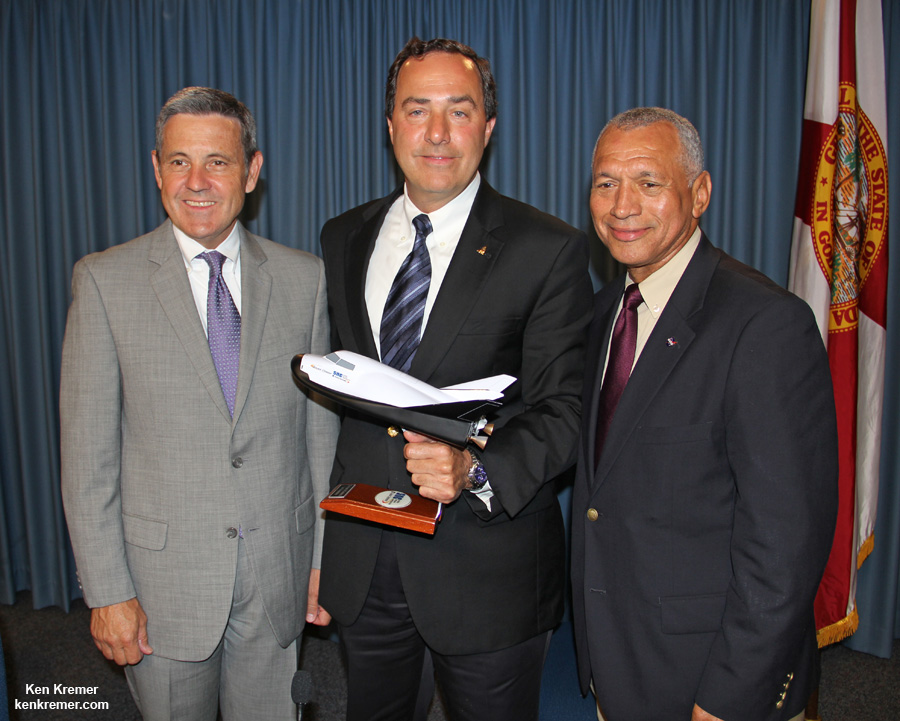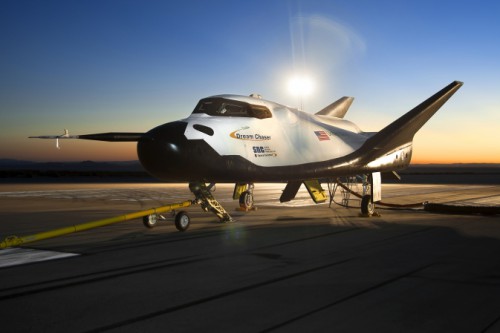
Of the three American companies who competed for a multi-billion-dollar NASA contract to launch astronauts to and from low-Earth orbit and the International Space Station (ISS) only two were selected, as was expected. Competition is a good thing in any industry, and spaceflight is no different, but that also means there must be a loser, and the loser in NASA’s Commercial Crew program is Sierra Nevada Space Systems (SNC) and their reusable Dream Chaser “mini shuttle.” However, that does not mean we will never see a Dream Chaser fly; it just means we won’t see NASA giving them extra money to continue development to serve the space agency’s agenda for contracting with private companies for crew transport to and from the ISS.
So where does this leave the Dream Chaser? SNC has released the following statement regarding NASA’s decision to skip Dream Chaser for two capsule designs with SpaceX’s Dragon V2 and Boeing’s CST-100:

“Sierra Nevada Corporation recognizes that NASA has made a selection of an alternative provider(s) in the Commercial Crew Transportation Capability Contract (CCtCap) competition. SNC is planning to have a debrief session with NASA soon to obtain the source selection statement and decision rationale. When this process is complete and after a thorough evaluation, SNC will elaborate further on its future options regarding the NASA Commercial Crew Transportation Capability (CCtCap) contract decision and the Dream Chaser program. Due to this pending activity SNC will have no further public statement at this time. We will be providing further information at a later date.”
“While SNC is disappointed NASA did not select its Dream Chaser® Space System for the CCtCap contract, SNC commends NASA for initiating the effort and is privileged to have been part of returning human space flight to the United States through our awarded contracts in all other phases of NASA’s Commercial Crew Program over the past four years.”
In a recent five-part exclusive interview with AmericaSpace (also available as a FREE PDF download for our readers at the right side of our website), SNC Space Systems VP Mark Sirangelo made it loud and clear—the company is ready to move forward with development of the Dream Chaser without NASA, as long as there is a business case for it.
“We have to see why we did not get the CCtCap award from NASA, and then we have to determine what are our cost course to push forward is,” said Sirangelo. “We have a lot of the hardware in place and a lot of things moving. We believe we have a path with other relationships to continue, we have to evaluate what happened. Was it money issues or technical or something else? So we are not saying at this time what we are going to do or not do. NASA is an important part of this, but we have been laying the foundation with other relationships as well. We have all the elements to be able to go ahead, but whether we go ahead is a matter of whether there is a business case for it. We can’t say at this time.”
Sierra Nevada has already begun to build their first Dream Chaser for an inaugural orbital flight test atop a ULA Atlas-V rocket in late 2016, and they have already purchased the Atlas-V for that flight. Whether that flight actually occurs, we will just have to wait and see. The company also has secured global partnerships with 21 space agencies, which gives them a solid foundation and “a path to continue” forward according to Sirangelo.
“A European or Japanese version of Dream Chaser is possible in the future,” added Sirangelo in our recent interview.
NASA has declined to comment as to how they came to their decision and why the agency decided to contract two crew capsules instead of one capsule and Dream Chaser’s unique lifting-body winged design.
Want to keep up-to-date with all things space? Be sure to “LIKE” AmericaSpace on Facebook and follow us on Twitter: @AmericaSpace




It’s so hard to know if there were good reasons not to choose SNC’s concept. Landing at airports would be very useful.
I hope SNC keeps on keeping on.
DC is just too pretty not to continue. Plus it has lowest G load for landing.
The money award would probably have meant success.
I certainly think, that NASA should have given all three support by dividing the money up accordingly. I thought the commercial effort was to keep competition strong. I am glad they at least chose two, although three would have been better.
I think at the end of the day it came down to risk — not risk from the vehicle or its systems, instead, risk of the system not being completed on time. While SNC did have a very successful drop test, they have fallen behind on their milestones, and at the end of the day had a less complete system than Boeing or SpaceX.
Hopefully, SNC’s work with ESA and JAXA will continue and their craft can be completed and used to go to and from orbit. Keep in mind that the CCtCAP awards are for 12 flights and that there may be more awarded at a future date. A working DC craft would certainly be a viable candidate at that time.
CST is an American Soyuz, and while it would be cheap and safe, it’s not a step forward. I hope ESA and JAXA fund DC, and I hope the Dragon is everything Musk is promising it will be. Returning spacecraft should land with dignity, and so far, only the shuttle has ever done that.
Although NASA’s decision with it’s CCtCap awards have been based upon political expediency, I feel that NASA could and should find a way to include SNC’s Dream Chaser. Maybe, NASA “is remembering” the problems it experienced with the initial development of the Shuttle, and that that could have been a factor in it’s CCtCap decision.
We don’t have to be talking billions of dollars here. Surely, it would be prudent for NASA to find some funds to guarantee that Dream Chaser remains alive. IMO, it would be prudent to have a third option with regard to getting US astronauts to and from the ISS and besides, Dream Chaser is too good a craft (both in projected performance, looks and potential commercial tourism applications) not to see it fully realised.
Come on NASA, give it a fighting chance, keep the “Dream” alive!
Just speculating. I wonder if the existence of the super secret Air Force “mini-shuttle” that has been quietly buzzing about above us for some time was taken into consideration at all when the decision was made. Maybe plans are afoot to expand it, modify it in other ways . . . ?
Back in 2011, Boeing had announced that it was studying the prospect of a bigger version of the secretive X-37B that is currently flying, which it dubbed X-37C. The latter would be much bigger in size and woud have been able to carry six astronauts to orbit. I’m not aware of any more details regarding this manned version of Boeing’s spaceplane, but I suspect that since the company was well into preparations at the time for the CST-100 as well and the latter was finally selected by NASA, that any plans for the X-37C would be mothballed (unless the US Air Force has something else in mind).
Very sad.